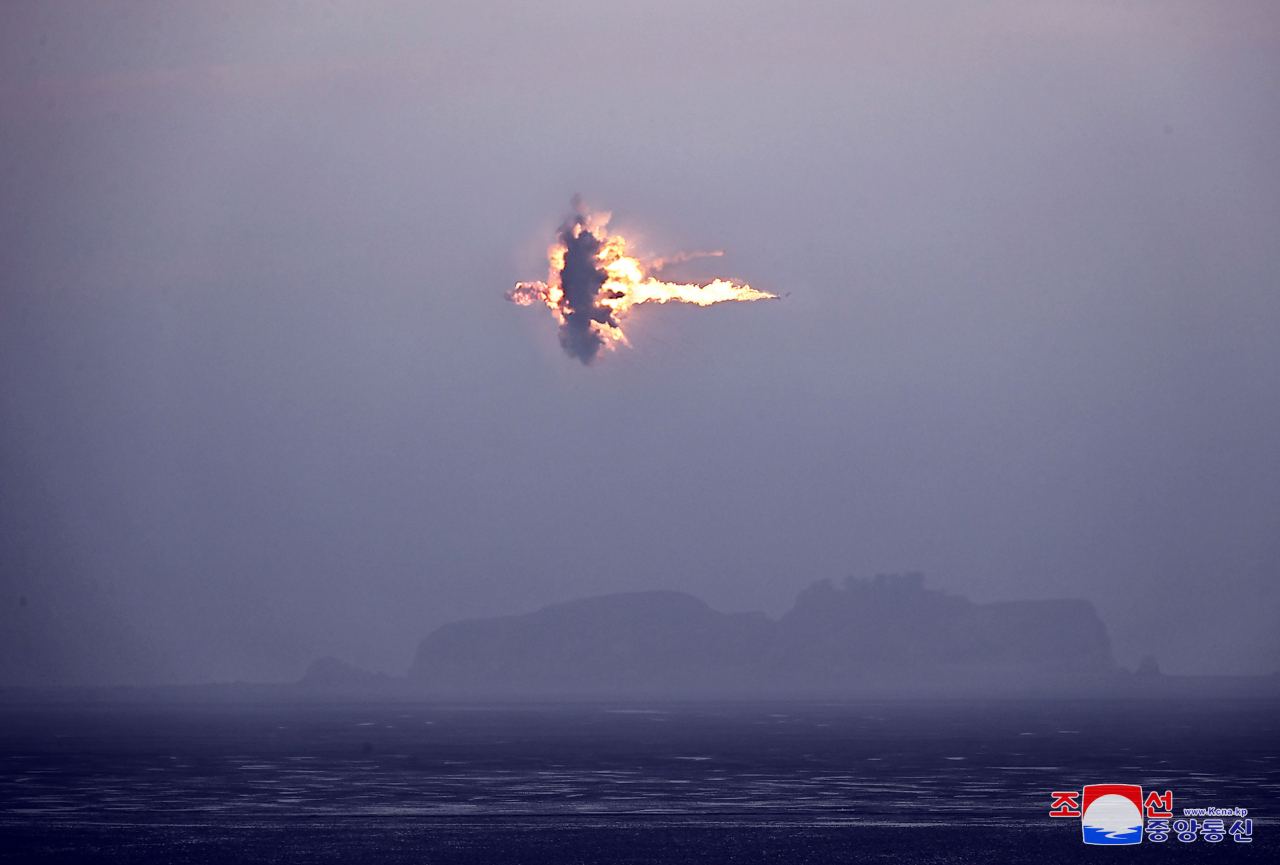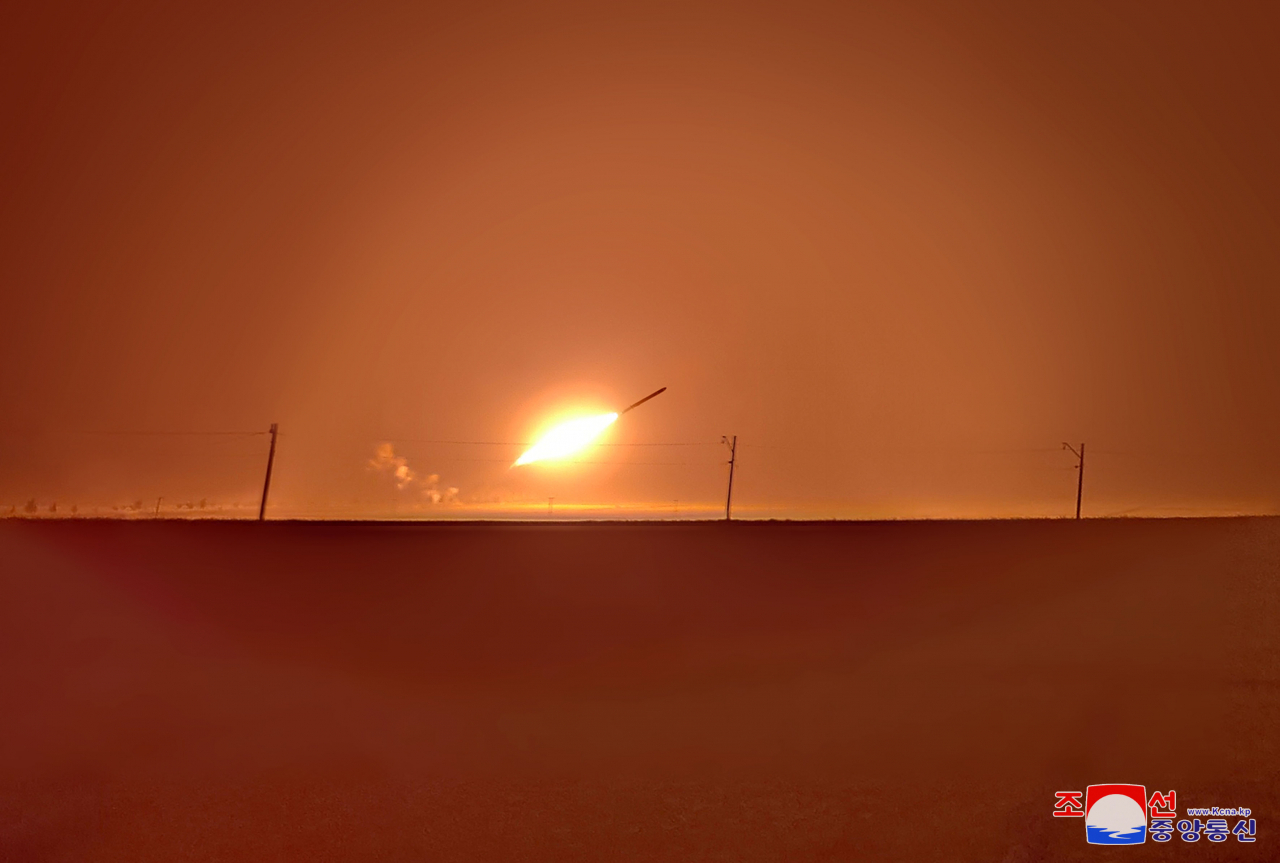N.Korea continues simulating tactical nuclear attacks
S. Korean military plays down NK state media reports, saying outcomes of drill 'exaggerated'
By Ji Da-gyumPublished : Sept. 3, 2023 - 15:25

North Korea conducted a purported live-fire drill simulating a "tactical nuclear attack" early Saturday by launching long-range strategic cruise missiles toward the West Sea, its state media claimed Sunday. However, the South Korean military dismissed the report as an "exaggeration," saying that North Korea may have failed to detonate a mock nuclear warhead in midair.
The latest drill is the second nuclear attack simulation in three days, which North Korean state media has labeled as a tit-for-tat response to combined field training exercises conducted by South Korea and the United States.
North Korea's state-run Korean Central News Agency underscored that Saturday's drill was conducted in response to aerial exercises staged between the allies over the West Sea on Thursday and Friday.
South Korea and US air forces conducted live-fire and bombing drills that simulated the interception of cruise missiles flying at low altitudes to avoid radar detection, the South Korean Air Force announced Thursday.
The allies' air exercises -- which were associated with Ulchi Freedom Shield -- also involved practicing precision strikes on key targets by penetrating the enemy's air defense system in the event of preemptive missile attacks by North Korea.
UFS is a regular, 11-day computer simulation-assisted command exercise that aims to strengthen the combined defense posture and alliance response capabilities amid mounting missile and nuclear threats posed by North Korea.
But in response, North Korea conducted "a live-fire drill simulating a tactical nuclear attack at dawn on Sept. 2 to issue a warning to the enemies about the actual nuclear crisis," the KCNA said in a Korean-language statement entitled "Tit-for-tat Drill Conducted for Important Objectives."
"The Central Military Commission of the Workers' Party of Korea issued an order to conduct the military drill to fully demonstrate the action will and capability to deter the enemies' intent to wage a war for invasion," the KCNA said.
North Korea's cruise missile-armed unit of the Korean People's Army in the western region "launched two long-range strategic cruise missiles equipped with mock nuclear warheads in a genuine wartime environment, following expedited approval procedures."
The long-range strategic cruise missiles, in this context, pertain to the Hwasal-1 and Hwasal-2 land-attack cruise missiles, often abbreviated as LACMs, which North Korea asserts can carry Hwasan-31 tactical nuclear warheads.
The two missiles were launched from the estuary of the Chongchon River toward the West Sea. These missiles traveled approximately 1,500 kilometers for a duration ranging from 7,672 to 7,681 seconds, or around two hours and eight minutes, following figure-eight flight patterns.
The missile subunit "successfully executed the nuclear strike mission with precision by detonating (mock warheads) in midair at a predetermined altitude of 150 meters above the target island."

NK bluff shows 'sense of urgency'
However, South Korea's Joint Chiefs of Staff on Sunday said the “announcement from North Korea this morning was exaggerated.”
“Not everything was successful,” the JCS said, declining to share further details when asked by The Korea Herald to provide its assessment of the KCNA’s report.
The South Korean military has been assessing that North Korea may have encountered failure in detonating one of the two mock nuclear warheads mounted on the cruise missile in midair during the live-fire drill, The Korea Herald learned through a conversation with a government source who is knowledgeable about the matter and wished to remain anonymous.
North Korea's state media also released photos of the flight and midair explosion of only one of the cruise missiles. This is noteworthy because North Korean state media typically highlights the specifics of successful tests to showcase its military capabilities.
The military has also been assessing whether North Korea indeed launched long-range strategic cruise missiles. On Saturday, the JCS confirmed that North Korea had fired cruise missiles toward the West Sea starting at around 4 a.m. local time, although it did not provide additional details.
Furthermore, the military has been scrutinizing the authenticity of the North Korean state media report from Thursday in which it claimed to have conducted a "tactical nuclear strike drill" targeting major command centers and operational airfields of the South Korean military the previous night.
State media asserted the successful execution of a nuclear strike mission by detonating mock nuclear warheads mounted on short-range ballistic missiles at a predetermined altitude of 400 meters above the target island.
However, the South Korean military's preliminary assessment contradicts North Korea's claims.
North Korean state media said the nighttime live-fire exercise on Wednesday was in response to combined aerial drills conducted by South Korea and the US earlier in the day. The US deployed its B-1B Lancer bomber aircraft for the air exercise.
The South Korean military has been investigating the reasons behind North Korea's exaggeration of its recent live-fire drills, which simulated tactical nuclear attacks and were conducted in response to the allies' air exercises.
Internal-oriented state media, primarily targeting North Korean citizens, such as the Rodong Sinmun, an organ of the ruling party, also featured reports on these two exercises.
North Korea's state media outlets that focus on internal audiences do not report every weapons test, as evidenced by their silence on the country's second failed attempt to launch a spy satellite into orbit on Aug. 24.
The South Korean military has evaluated that the North Korean state media's reports on the two recent live-fire drills convey the sense of urgency of the Kim Jong-un regime, The Korea Herald learned during the conversation with the source.



















![[Today’s K-pop] Treasure to publish magazine for debut anniversary](http://res.heraldm.com/phpwas/restmb_idxmake.php?idx=642&simg=/content/image/2024/07/26/20240726050551_0.jpg&u=)